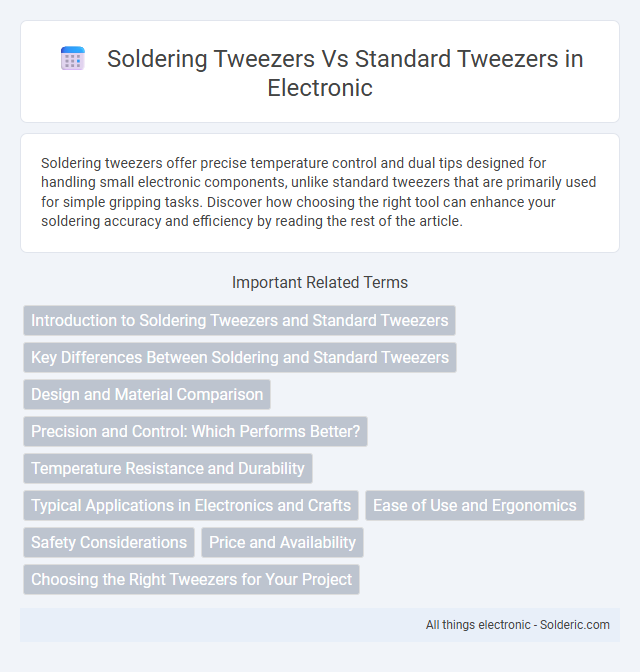Soldering tweezers offer precise temperature control and dual tips designed for handling small electronic components, unlike standard tweezers that are primarily used for simple gripping tasks. Discover how choosing the right tool can enhance your soldering accuracy and efficiency by reading the rest of the article.
Comparison Table
| Feature | Soldering Tweezers | Standard Tweezers |
|---|---|---|
| Purpose | Melting solder to join electronic components | Gripping and manipulating small objects |
| Heating Element | Built-in heating tips, electrically powered | None, non-heated metal tips |
| Material | Heat-resistant metals with insulated handles | Stainless steel or plastic |
| Use Case | Surface mount device (SMD) soldering | Precision picking, assembly, general use |
| Temperature Control | Adjustable temperature settings | Not applicable |
| Ergonomics | Designed to reduce thermal fatigue | Simple design, no thermal considerations |
| Price Range | Higher, specialized tool | Low to moderate, general tool |
Introduction to Soldering Tweezers and Standard Tweezers
Soldering tweezers are specialized tools designed for precise electronic repair, featuring two heated tips that simultaneously grip and solder or desolder components, ideal for surface-mount devices (SMDs). Standard tweezers, commonly made from stainless steel or anti-magnetic materials, serve general purposes such as handling small objects or components without heating capabilities. The key distinction lies in soldering tweezers' integration of temperature control and heating elements, enabling efficient circuit board work, whereas standard tweezers provide mechanical precision without thermal function.
Key Differences Between Soldering and Standard Tweezers
Soldering tweezers feature integrated heating elements that allow precise melting and manipulation of solder, unlike standard tweezers which are designed solely for gripping and positioning small components without heat. The tips of soldering tweezers are typically made from heat-resistant materials and are shaped to handle solder joints efficiently, while standard tweezers prioritize fine control and grip for delicate tasks. Key differences include the ability of soldering tweezers to deliver controlled thermal energy directly to electronic components, enhancing efficiency in soldering tasks compared to the purely mechanical function of standard tweezers.
Design and Material Comparison
Soldering tweezers feature a dual-tip design made from heat-resistant materials such as stainless steel or ceramic, enabling precise handling of small electronic components during soldering without damage. Standard tweezers usually have a single tip constructed from stainless steel or plastic, designed for general use without heat resistance. The enhanced design and specialized materials of soldering tweezers provide better thermal durability and accuracy essential for electronics work compared to the simpler, multipurpose build of standard tweezers.
Precision and Control: Which Performs Better?
Soldering tweezers provide superior precision and control compared to standard tweezers due to their specialized design that integrates heating elements for accurate component handling and soldering. The enhanced grip and ergonomic shape of soldering tweezers minimize hand fatigue and allow for delicate manipulation of small electronic parts. Standard tweezers often lack fine temperature control and tend to offer less stability during intricate tasks, making soldering tweezers the preferred choice for precision electronics work.
Temperature Resistance and Durability
Soldering tweezers are engineered with high-grade materials such as stainless steel or ceramic tips, delivering superior temperature resistance up to 450degC, essential for precise soldering applications. Standard tweezers, typically made from stainless steel without specialized insulation, offer limited heat resistance and can degrade quickly under high thermal stress. The enhanced durability of soldering tweezers ensures consistent performance and longevity in electronics assembly and repair environments.
Typical Applications in Electronics and Crafts
Soldering tweezers are essential for precision work in electronics, allowing for hands-free heating and removal of small surface-mounted components like resistors and capacitors. Standard tweezers, preferred in crafts, provide fine control for handling delicate materials such as beads, wires, and small hardware pieces. Your choice depends on whether you need heat application for soldering or simple manipulation in crafting projects.
Ease of Use and Ergonomics
Soldering tweezers feature dual heated tips designed for precise and efficient desoldering, reducing hand fatigue during repetitive tasks through ergonomic handles that provide improved grip and control. Standard tweezers, while versatile for general handling and placement, often lack the specialized heating element and ergonomic enhancements, resulting in less comfort during extended soldering sessions. The tailored design of soldering tweezers significantly enhances ease of use in electronics assembly compared to the simpler construction of standard tweezers.
Safety Considerations
Soldering tweezers are designed with insulated handles and heat-resistant tips to protect you from burns and electrical shocks during precise electronics work. Standard tweezers lack this insulation, increasing the risk of accidental burns or short circuits when used near hot soldering irons or live circuits. Prioritizing soldering tweezers enhances safety by minimizing exposure to high temperatures and electrical hazards in delicate tasks.
Price and Availability
Soldering tweezers typically cost more than standard tweezers due to their specialized design and heating elements, making them a premium investment for precise electronic work. Availability of soldering tweezers is generally lower, often found in specialized electronics or industrial supply stores compared to the wide range of standard tweezers available in general retail outlets and online marketplaces. Your choice depends on budget constraints and the specific functionality required for delicate soldering tasks.
Choosing the Right Tweezers for Your Project
Selecting the right tweezers for your project depends on the task precision and material sensitivity; soldering tweezers feature heated tips designed for melting and removing solder, providing efficient dual-point heating for surface-mount components. Standard tweezers, made from anti-static stainless steel or ceramic, offer precise control for delicate parts but lack heating capability. Assess the project's heat requirements and component delicacy to determine whether soldering tweezers' thermal function or standard tweezers' non-heated precision suits your needs best.
Soldering tweezers vs standard tweezers Infographic

 solderic.com
solderic.com